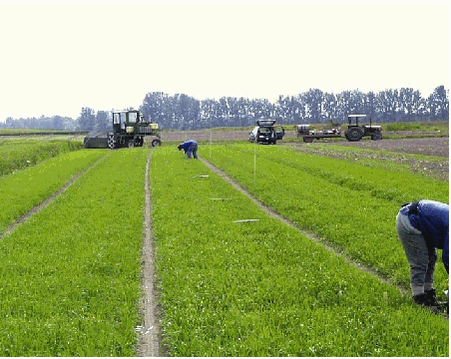| Front page | | Contents | | Previous | | Next |
Deposition of Pesticides on the Soil Surface
Introduction
The conventional technique used to apply pesticides to agricultural crops is by diluting the pesticide in water. The spray solution can then be distributed evenly on the target crop by boom sprayers equipped with an atomiser system. The commonly used atomiser system is hydraulic nozzles where the spray liquid is atomised into droplets forming a spray with a pattern, which enables the even distribution of the spray on the intended target. The boom and nozzles are typically at a height of 0.4-0.5 meters above the crop/soil. When the spray cloud passes the crop a proportion of the droplets are deposited on the crop. However some of the droplets are not deposited during the journey through the crop. Others might be reflected from the leaves or deleted through run-off from the leaves. Therefore, even in dense crops a proportion of the spray liquid will be deposited on the soil below the crop.
A number of factors affect the deposition of pesticide on the crop and hence the partition between plant/crop deposit and soil deposit. The surface structure of the crop interacts with spray application factors and properties of the spray in retention. Large droplets with a high surface tension are not retained on the waxy leaves found on many important crop plants to the same extent as on plants with little or no wax layer (Bengtsson, 1961; Welker, 1979).
Retention may be affected by other spray application factors such as electric charging of the droplets (Göhlich et al, 1985; Hislop et al, 1983) and air-assistance to hydraulic boom sprayers (Cooke et al, 1990; Hislop et al, 1993). Retention may also be affected by leaf morphological features such as shape (Tu et al, 1986), leaf orientation (Davies et al, 1967; de Ruiter & Uffing, 1988) and leaf age (Anderson et al, 1987).
A part of the spray can be lost during the application before the droplets are deposited on plants or soil. Droplets can be transported out of the sprayed field by spray drift. This loss however is under normal climatic conditions negligible. Another loss comes from evaporation during the travel from nozzle to target. This part is not quantified but theoretical considerations suggest that it can be of significant importance under some climatic conditions with high temperature and low humidity (Reichard et al., 1992; Kaul et al., 1996). The proportion of the spray, which is not deposited on plants parts during the travel through the crop, will be deposited on the soil surface. From the short introduction above it can be understood that ground deposit is a function of the collection efficiency of the canopy. Some investigations have measured soil deposition of pesticides on the soil surface. The typical aim has however been to investigate the influence of different changes in application variables, canopy density or pesticide formulation on the qualitative and quantitative deposit in crop and on the ground. The investigations therefore typically include only one or a few crop growth stages.
The aim of this study was to describe the deposition of pesticides on the ground in four crops covering all relevant applications from very early growth stages and until near maturity. The four crops involved were winter wheat, spring barley, potatoes and sugar beet. The influence of droplet size and pesticide formulation on deposition in winter wheat and spring barley was tested in a separate investigation covering only one growth stage.

Figure 1a. Overview of deposit experiment in a cereal crop.
Figur 1a. Oversigtsbillede fra afsætningsforsøg i en kornafgrøde.
| Front page | | Contents | | Previous | | Next | | Top |
|